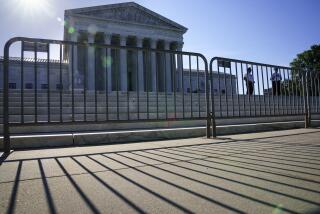A revolution that had run its course
- Share via
WILLIAM H. Rehnquist was one of the great chief justices in American history. Over the last three decades, he moved the Supreme Court in a more conservative direction, advancing states’ rights, expanding police powers and returning the country to its Tocquevillian roots. But in recent years his colleagues have handed him a series of setbacks in areas dear to him -- including religion, property rights, federalism and capital punishment -- signaling that perhaps the time had come for fresh leadership.
Leading the court is a notorious challenge. Justices are a famously independent bunch. A chief justice cannot order his colleagues to vote one way or the other; he cannot hire them, fire them or change their salaries. His only real power consists of speaking first at the internal conference where they vote on cases, and assigning writing duties when he is in the majority. The court functions like nine little law firms where, as Justice Felix Frankfurter once said, each justice “is his own sovereign.” Or perhaps, as Justice Oliver Wendell Holmes put it more cynically, the court is more like “nine scorpions in a bottle.”
Nevertheless, some have managed to exercise leadership. Our nation’s greatest chief justice, John Marshall, convinced his colleagues in the early 1800s to unify behind opinions establishing judicial review, the supremacy of federal law and the creation of national institutions such as the federal bank. Chief Justice Earl Warren, a former California governor, brought the court together in the 1950s and 1960s to unanimously strike down segregation and to expand protections for criminal defendants.
Rehnquist will be remembered as one of the great chief justices because he, too, moved the court in his direction.
Before he became chief, Rehnquist was known as the “Lone Ranger” for his solitary dissents. Two decades later, many of those then-minority views are now the law. He successfully expanded the flexibility of police to search and question suspects, and he made it more difficult for defendants to stretch out their trials with frivolous appeals or attacks on the death penalty.
Rehnquist’s court allowed religious groups to compete for government funds, which has had the effect, among other things, of allowing parents to use vouchers at religious schools. He demanded that judges interpret the Constitution based on its text and the original understanding of those who ratified it, rather than evolving to meet the needs of present-day society. He was a Scalia or a Thomas before it was fashionable.
Rehnquist sought to return the country to its Tocquevillian roots, with a central place for civil society -- churches, clubs, private organizations -- and less government control and regulation. He advanced decentralization by bolstering the states as a counterweight to the national government and requiring compensation to property owners who suffer from regulation. While Rehnquist never succeeded in overturning Roe v. Wade (which was decided in 1973 when he was an associate justice), his court permitted restrictions on the right to abortion, and while he did not eliminate affirmative action in school admissions, his court made the use of race more difficult to justify.
But toward the end of his reign, Rehnquist’s colleagues began to dig in their heels. Rehnquist’s efforts to reverse federal interference in state criminal justice systems ran aground on the death penalty. This year, for instance, the court held unconstitutional the execution of murderers who were minors at the time of their crime, and three years ago, the court barred state execution of the mentally retarded. Rehnquist dissented both times.
Rehnquist’s efforts to check the expansion of Washington’s powers also stalled this year. In Gonzales v. Raich, the court allowed federal drug laws to trump California’s medical marijuana initiative, which reversed the trend of recent decisions against federal laws prohibiting gender-based violence and handguns in school zones. Rehnquist dissented.
In Kelo v. New London, the court held that cities may transfer private property to private developers in the interests of economic improvement. Again, Rehnquist dissented. Justice John Paul Stevens, a President Ford appointee who has emerged as the leader of the court’s liberal wing, wrote the majority opinions in both cases.
Even Rehnquist’s efforts to allow more space for religion in public life crested. In McCreary v. ACLU, five justices ordered Kentucky authorities to remove the Ten Commandments from a county courthouse. Rehnquist dissented. He did write an opinion in a separate case announced the same day that allowed a “six-foot high monolith” inscribed with the Ten Commandments to remain on the Texas Capitol lawn as a ceremonial recognition of religion. But he was unable to get a fifth vote to make his opinion one for the court as a whole; the deciding vote was cast by Justice Stephen Breyer, no fellow traveler of Rehnquist’s, who was moved less by legal arguments and more by the fact that the monolith had sat there for 40 years.
While this stalemate over the court’s future does not undermine the chief justice’s legacy, it suggests that the Rehnquist revolution had already run its full course. Now, only two months after Justice Sandra Day O’Connor’s surprise resignation from the court, President Bush has a second opportunity to name a new justice. Bush would be fortunate to find someone like Rehnquist who can give the court the guidance and coherence it lacks.
More to Read
Get the L.A. Times Politics newsletter
Deeply reported insights into legislation, politics and policy from Sacramento, Washington and beyond. In your inbox three times per week.
You may occasionally receive promotional content from the Los Angeles Times.










